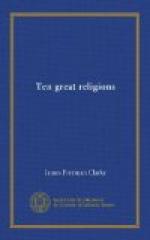The month of March is devoted to ascetic exercises, especially to the famous one of swinging suspended by hooks. It is a festival in honor of Siva. A procession goes through the streets and enlists followers by putting a thread round their necks. Every man thus enlisted must join the party and go about with it till the end of the ceremony under pain of losing caste. On the day before the swinging, men thrust iron or bamboo sticks through their arms or tongues. On the next day they march in procession to the swinging tree, where the men are suspended by hooks and whirled round the tree four or five times.
It is considered a pious act in India to build temples, dig tanks, or plant trees by the roadside. Rich people have idols in their houses for daily worship, and pay a priest who comes every morning to wake up the idols, wash and dress them, and offer them their food. In the evening he comes again, gives them their supper and puts them to bed.
Mr. Gangooly, in his book, from which most of the above facts are drawn, denies emphatically the statement so commonly made that Hindoo mothers throw their infants into the Ganges. He justly says that the maternal instinct is as strong with them as with others; and in addition to that, their religion teaches them to offer sacrifices for the life and health of their children.
Sec. 9. Relation of Brahmanism to Christianity.
Having thus attempted, in the space we can here use, to give an account of Brahmanism, we close by showing its special relation as a system of thought to Christianity.
Brahmanism teaches the truth of the reality of spirit, and that spirit is infinite, absolute, perfect, one; that it is the substance underlying all existence. Brahmanism glows through and through with this spirituality. Its literature, no less than its theology, teaches it. It is in the dramas of Calidasa, as well as in the sublime strains of the Bhagavat-gita. Something divine is present in all nature and all life,—
“Whose dwelling is the
light of setting suns,
And the round ocean
and the living air.”
Now, with this Christianity is in fullest agreement. We have such passages in the Scripture as these: “God is a Spirit”; “God is love; whoso dwelleth in love dwelleth in God, and God in him”; “In him we live, and move, and have our being”; “He is above all, and through all, and in us all.” But beside these texts, which strike the key-note of the music which was to come after, there are divine strains of spiritualism, of God all in all, which come through a long chain of teachers of the Church, sounding on in the Confessions of Augustine, the prayers of Thomas Aquinas, Anselm, Bonaventura, St. Bernard, through the Latin hymns of the Middle Ages, and develop themselves at last in what is called romantic art and romantic song. A Gothic cathedral like Antwerp or Strasburg,—what is it but a striving upward of the soul to lose itself




